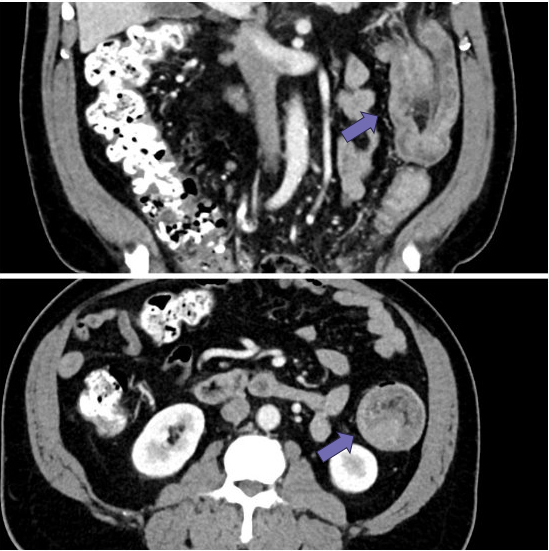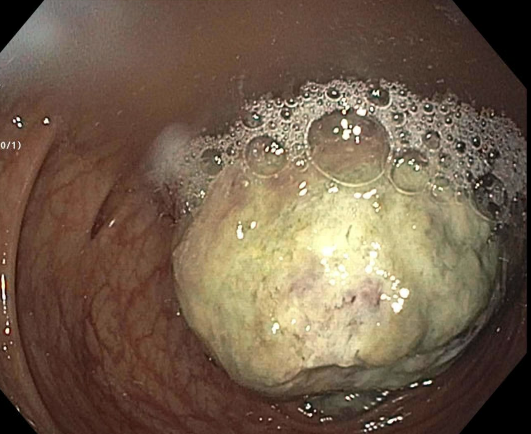Sunday Poster Session
Category: Colon
P0424 - When Bowel Telescopes: A Hidden Adenocarcinoma Masquerading as Post-Cleanse Complications
Sunday, October 26, 2025
3:30 PM - 7:00 PM PDT
Location: Exhibit Hall

Ahmad Al Homaid, MD
Nazareth Hospital
Philadelphia, PA
Presenting Author(s)
Ahmad Alhomaid, MD1, Rumael Jawed, MD1, Elias Helal, MD1, Fnu Hamidullah, MD2
1Nazareth Hospital, Philadelphia, PA; 2Trinity health midatlantic, Philadelphia, PA
Introduction: Adult colocolonic intussusception is rare, comprising < 5% of all intussusceptions, with 80% caused by malignant lesions. This case demonstrates an unusual presentation of colorectal adenocarcinoma manifesting as intussusception following herbal colon cleanse use, highlighting diagnostic challenges in adults with nonspecific abdominal symptoms.
Case Description/
Methods: A 67-year-old male with history of prostate cancer s/p radiation presented with one-month history of abdominal pain, bloating, and diarrhea following use of herbal colon cleanse. Initial symptoms included bloody diarrhea that resolved, but persistent lower abdominal pain continued. Physical exam revealed bilateral lower quadrant tenderness. CT abdomen/pelvis demonstrated colocolonic intussusception at splenic flexure involving distal transverse colon to descending colon with wall thickening. Colonoscopy was attempted but terminated at sigmoid colon due to complete obstruction; biopsy showed inflammatory debris. Due to irreducible intussusception, patient underwent laparoscopic left colectomy with colostomy creation. Surgical pathology revealed 4cm moderately-differentiated invasive adenocarcinoma extending through muscularis propria into pericolonic tissue, with negative margins and lymph nodes (0/9). Patient had uncomplicated recovery with return of bowel function.
Discussion: This case illustrates adult colocolonic intussusception as a rare presentation of colorectal malignancy. The temporal association with herbal cleanse use may represent coincidental timing or potential triggering factor. Key learning points include: high index of suspicion for underlying malignancy in adult intussusception, critical role of colonoscopy for tissue diagnosis despite technical limitations with obstructing lesions, and multidisciplinary approach combining endoscopic evaluation with surgical management.

Figure: CT abdomen/pelvis with contrast showing colocolonic intussusception at the splenic flexure on coronal (A) and axial (B) views (arrows), secondary to underlying adenocarcinoma.

Figure: Endoscopic image showing a large polypoid lesion in the colon.
Disclosures:
Ahmad Alhomaid indicated no relevant financial relationships.
Rumael Jawed indicated no relevant financial relationships.
Elias Helal indicated no relevant financial relationships.
Fnu Hamidullah indicated no relevant financial relationships.
Ahmad Alhomaid, MD1, Rumael Jawed, MD1, Elias Helal, MD1, Fnu Hamidullah, MD2. P0424 - When Bowel Telescopes: A Hidden Adenocarcinoma Masquerading as Post-Cleanse Complications, ACG 2025 Annual Scientific Meeting Abstracts. Phoenix, AZ: American College of Gastroenterology.
1Nazareth Hospital, Philadelphia, PA; 2Trinity health midatlantic, Philadelphia, PA
Introduction: Adult colocolonic intussusception is rare, comprising < 5% of all intussusceptions, with 80% caused by malignant lesions. This case demonstrates an unusual presentation of colorectal adenocarcinoma manifesting as intussusception following herbal colon cleanse use, highlighting diagnostic challenges in adults with nonspecific abdominal symptoms.
Case Description/
Methods: A 67-year-old male with history of prostate cancer s/p radiation presented with one-month history of abdominal pain, bloating, and diarrhea following use of herbal colon cleanse. Initial symptoms included bloody diarrhea that resolved, but persistent lower abdominal pain continued. Physical exam revealed bilateral lower quadrant tenderness. CT abdomen/pelvis demonstrated colocolonic intussusception at splenic flexure involving distal transverse colon to descending colon with wall thickening. Colonoscopy was attempted but terminated at sigmoid colon due to complete obstruction; biopsy showed inflammatory debris. Due to irreducible intussusception, patient underwent laparoscopic left colectomy with colostomy creation. Surgical pathology revealed 4cm moderately-differentiated invasive adenocarcinoma extending through muscularis propria into pericolonic tissue, with negative margins and lymph nodes (0/9). Patient had uncomplicated recovery with return of bowel function.
Discussion: This case illustrates adult colocolonic intussusception as a rare presentation of colorectal malignancy. The temporal association with herbal cleanse use may represent coincidental timing or potential triggering factor. Key learning points include: high index of suspicion for underlying malignancy in adult intussusception, critical role of colonoscopy for tissue diagnosis despite technical limitations with obstructing lesions, and multidisciplinary approach combining endoscopic evaluation with surgical management.

Figure: CT abdomen/pelvis with contrast showing colocolonic intussusception at the splenic flexure on coronal (A) and axial (B) views (arrows), secondary to underlying adenocarcinoma.

Figure: Endoscopic image showing a large polypoid lesion in the colon.
Disclosures:
Ahmad Alhomaid indicated no relevant financial relationships.
Rumael Jawed indicated no relevant financial relationships.
Elias Helal indicated no relevant financial relationships.
Fnu Hamidullah indicated no relevant financial relationships.
Ahmad Alhomaid, MD1, Rumael Jawed, MD1, Elias Helal, MD1, Fnu Hamidullah, MD2. P0424 - When Bowel Telescopes: A Hidden Adenocarcinoma Masquerading as Post-Cleanse Complications, ACG 2025 Annual Scientific Meeting Abstracts. Phoenix, AZ: American College of Gastroenterology.
